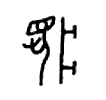Shell Bone Script of character Strange is
The above script depicts a person riding a horse. The current widely accepted theory is that horses were domesticated in Central Asia around 4000 BCE and were introduced to China from there. Initially, horses were mainly used for pulling carts, especially war chariots. Cavalry only appeared in China during the Spring and Autumn period. This means that during the Oracle Bone Script period, Chinese people did not ride horses. Therefore, the original meaning of the character "奇" was likely a person from the Western regions riding a horse, which referred to the non-Han people, or "Hu people." For the people in the Yellow River basin, riding a horse was a strange thing, which is the explanation given by the Pictograph Dictionary.
This explanation seems reasonable, but it could also be that the appearance of horse-riding Westerners seemed strange to the Chinese, or perhaps it was a combination of both.
Big Seal Script of character Strange is
the upper part "大" represents the person riding the horse, and the lower part "可" represents the horse and saddle.
Small Seal Script of character Strange is
The Small Seal Script is similar to the Large Seal Script in structure.
Clerical Script of character Strange is
As time passed, the meaning of "奇" as "strange" became more prevalent than the original meaning of "riding a horse." Therefore, the ancient people added a horse radical (馬) to create a new character "騎" specifically to refer to riding a horse or a horse rider.
Let's see the character Ride.
Big Seal Script of character Ride is
On the left is the horse radical, and on the right is the character "奇."
Small Seal Script of character Ride is
The left part is the Small Seal Script form of the horse radical, and the right part is the Small Seal Script form of "奇," similar to the Large Seal Script form of "奇."
Clerical Script (隶书) of character Ride is
Simplified Song Typeface of character Ride is
The original form of "奇" related to horse riding has disappeared, and now it only retains the meaning of "strange", the original meaning of riding is replaced by 骑.





















































